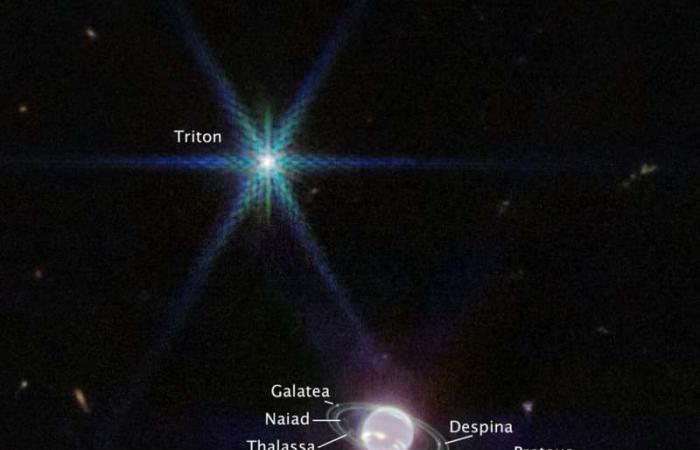The James Webb Space Telescope, a collaboration between the US space agency NASA, the European Space Agency (ESA) and the Canadian Space Agency (CSA), once again demonstrates its capabilities with its first image of the planet Neptune. The telescope not only captured the clearest image of this strange planet’s rings in more than 30 years, but thanks to the cameras it is equipped with, it presents this frozen giant in a whole new light, the website says the ESA.
The most striking aspect of the new data from the James Webb Space Telescope is the clear image of the planet’s dynamic rings – some of which have never been seen, let alone with this clarity, since the Voyager 2 flyby in 1989. a few bright narrow rings, telescope images clearly show Neptune’s fainter dust lanes. The extremely stable and precise image quality also makes it possible for these very subtle rings to be detected so close to Neptune.
Neptune has fascinated and puzzled researchers since its discovery in 1846. Located 30 times farther from the Sun than Earth, Neptune orbits in one of the darkest regions of our solar system. At that extreme distance, the Sun is so small and faint that the light from Neptune at high noon is similar to a diffuse twilight on Earth.
This planet is characterized as a frozen giant due to the chemical composition of its interior. Compared to the gas giant planets Jupiter and Saturn, Neptune is much richer in elements heavier than hydrogen and helium. This is evident in the blue appearance of Neptune in the images captured by the Hubble space telescope of NASA and ESA, a fact determined by the small amounts of methane (gas), according to esa.int.
Neptune’s 164-year orbit means that its north pole, at the top of the telescope image, is not visible to astronomers. But the James Webb telescope images suggest an interesting brightness in that area, ESA notes.
A previously known vortex at the South Pole is evident in the captured image, but for the first time the telescope has revealed a continuous band of clouds surrounding it.
Also, James Webb captured in images seven of the 14 known Moons of Neptune. Dominating this “portrait” of Neptune is a very bright bright point, which presents the diffraction peaks observed in many of the images transmitted by the telescope; it is not a star, but Neptune’s most unusual Moon, Triton.
Covered in frozen nitrogen, Triton reflects, on average, 70% of the sunlight that reaches it. Triton far outshines Neptune in brightness because the planet’s atmosphere is darkened by methane absorption at James Webb wavelengths. Triton orbits Neptune in a bizarre reverse (retrograde) orbit, leading astronomers to speculate that this moon was actually a Kuiper Belt object that was gravitationally captured by Neptune.
Additional studies by the James Webb telescope that will focus on Triton, but also on Neptune, are scheduled for next year.
A true gem of highly complex engineering, the James Webb telescope is the largest and most powerful telescope ever sent into space.
Presented as a successor to the Hubble space telescope, launched in 1990, the James Webb telescope has the mission of exploring with unparalleled precision all phases of the cosmos, up to the first years of the Universe’s existence and the formation of the first galaxies.
The James Webb telescope will be placed in an orbit around the Sun, at a distance of 1.5 million kilometers from Earth.
Tags: image captured James Webb telescope clearest view Neptunes rings
-





